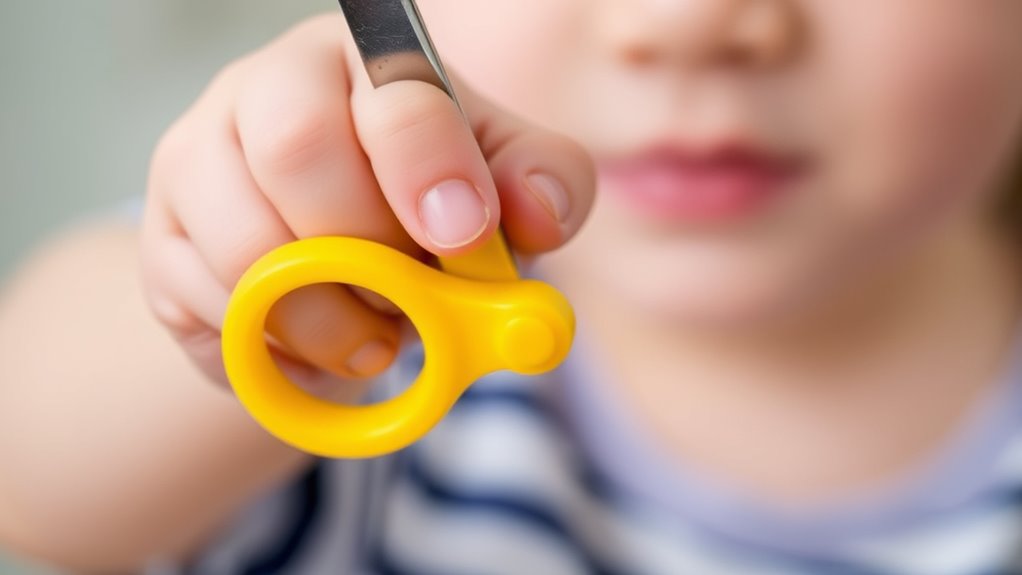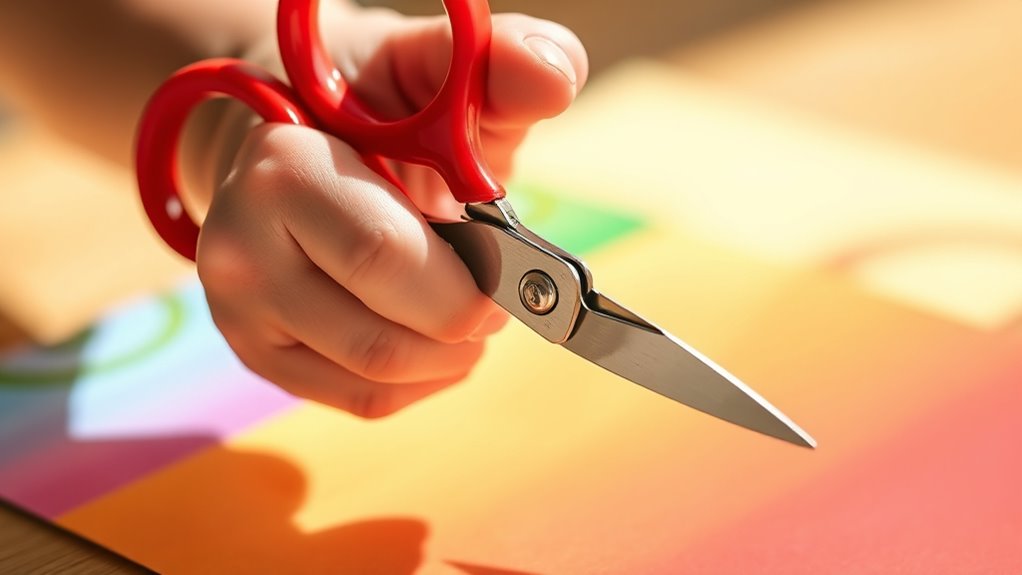To develop fine motor skills from grasping to scissor use, focus on strengthening hand-eye coordination through practice. Start with simple grasp activities and gradually introduce tasks like holding and controlling scissors. Consistent practice helps improve grip, control, and precision, making cutting easier and more accurate. As these skills progress, you’ll notice better coordination and confidence in daily tasks. Keep exploring, as understanding the key steps can support your child’s or your own development in these essential movements.
Key Takeaways
- Developing a proper pencil grasp enhances control for precise cutting with scissors.
- Hand-eye coordination is essential for accurately guiding scissors along patterns or lines.
- Strengthening finger muscles improves the ability to open and close scissors smoothly.
- Practicing scissor skills reinforces fine motor control and reinforces grip stability.
- Consistent practice from grasping to cutting fosters independence and precision in scissor use.

Have you ever wondered how small movements like writing, cutting, or buttoning become possible? It all starts with the development of fine motor skills, which involve precise movements of your fingers, hands,, and wrists. One of the first steps in this process is improving hand-eye coordination, allowing you to smoothly guide your hand based on what your eyes see. This skill is essential because it helps you coordinate visual input with hand movements, making tasks like picking up a pencil or aligning scissors much easier. As you practice, your brain learns to process visual information and translate it into controlled, accurate movements, laying the foundation for more complex activities.
Developing hand-eye coordination is essential for smooth, accurate movements like writing and cutting.
A key part of developing fine motor skills is mastering pencil grasp development. When you’re young, grasping a pencil properly isn’t automatic; it takes time and practice. A proper pencil grasp means holding the pencil with a comfortable, controlled grip that allows for precise movements. This grip not only helps you write more neatly but also reduces fatigue and strain on your hand. As you improve, you learn to balance your fingers around the pencil, with your thumb and index finger controlling movement while your middle finger supports. Developing this skill requires repeated practice, but once it becomes natural, it makes writing, drawing, and coloring much more efficient.
Building hand-eye coordination and refining your pencil grasp go hand in hand. As your coordination improves, your ability to control small movements gets better, making tasks like cutting with scissors easier. When learning to use scissors, you must coordinate your hand movements to open and close the blades smoothly while maintaining proper grip. This skill requires both strength and precision, which develop gradually through practice. Initially, you might find it tricky to cut straight lines or follow a pattern, but with patience, your hand-eye coordination sharpens, and your scissor skills improve. You learn to judge distances and control pressure, leading to cleaner cuts and more confidence.
As you continue practicing, you’ll notice how these skills reinforce each other. Better hand-eye coordination enhances your ability to handle small objects and perform delicate tasks. Meanwhile, developing a solid pencil grasp and proper scissor technique makes these tasks feel more natural and less frustrating. Consistent practice is key—whether you’re drawing, cutting paper, or buttoning a shirt—because each activity reinforces the neural pathways involved in fine motor control. Over time, you’ll find that what once seemed difficult becomes second nature, giving you greater independence and precision in everyday activities. Fine motor skills development is essential for overall coordination and dexterity.
Frequently Asked Questions
When Should a Child Be Able to Use Scissors Independently?
Your child can typically use scissors independently around age 4 to 5, reaching key age milestones. Before letting them try solo, make sure they understand safety tips like proper handling and supervision. Watch for their ability to hold scissors correctly, make simple cuts, and stay focused. Remember, every child develops at their own pace, so be patient and provide guidance to build their confidence and safety skills.
How Can I Encourage My Child’s Fine Motor Development at Home?
You can boost your child’s fine motor skills at home by encouraging activities like playdough exercises and pegboard activities, which naturally develop hand strength and coordination. Set up simple, fun tasks that involve pinching, squeezing, and threading. These playful exercises help your child improve their grasp and precision, making daily tasks easier. Consistent practice and positive reinforcement will build their confidence and foster steady progress in their fine motor development.
Are There Specific Activities That Improve Grasp Strength?
You can improve your child’s grasp strength with simple activities like hand grip exercises, which involve squeezing a soft ball or stress toy. Additionally, toy recommendations like building blocks or grip-strengthening tools encourage activity. These exercises make strengthening fun, helping your child develop better hand control essential for tasks like grasping, holding, and eventually using scissors. Incorporate these activities regularly to support steady progress.
What Are Signs of Fine Motor Skill Delays?
You might notice signs of fine motor skill delays if your child struggles with hand-eye coordination, making tasks like catching or stacking difficult. They may also have trouble developing a proper pencil grip, leading to awkward writing or fatigue. These signs suggest their hand muscles and coordination aren’t developing as expected, which can impact activities like cutting with scissors or buttoning clothes. Early intervention can support their progress effectively.
How Does Sensory Processing Affect Fine Motor Skill Development?
Sensory processing acts like the engine beneath the train, propelling your child’s fine motor skills forward. When sensory integration works smoothly, tactile feedback helps them refine movements like grasping or cutting. If sensory signals are disrupted, they may struggle with coordination or grip strength. By supporting sensory processing, you help your child develop the skills needed for tasks like using scissors, turning fine motor challenges into stepping stones rather than barriers.
Conclusion
By mastering activities like grasping and scissor use, you help develop your child’s fine motor skills, laying a foundation for future learning. Did you know that by age three, most children can cut along a straight line? Supporting their progress now boosts confidence and independence later. Keep encouraging these skills with fun, simple tasks—your child’s growth is unfolding right before your eyes!










